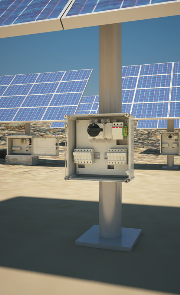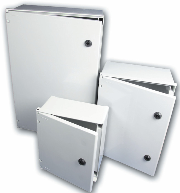 Enclosures play a critical role when it comes to protecting valuable equipment and safeguarding personnel. Choosing an enclosure is therefore just as important as selecting the electrical components.
Enclosures play a critical role when it comes to protecting valuable equipment and safeguarding personnel. Choosing an enclosure is therefore just as important as selecting the electrical components.
Using a substandard product could result in leaks, become a risk to public safety and be prone to vandalism. If this does happen, not only will the enclosure have to be replaced, as will any damaged components, but it could result in costly downtime and even a potential compensation payment. Using the right solution will significantly lower the risk of damage to high value systems.
However, as well as the quality of the enclosure itself, its material and properties also need to be considered for each individual application. There is a wide variety of materials available, and it is important to recognise each one for its strengths and weaknesses in differing situations – by understanding the pros and cons of each solution, the right enclosure can be specified and fitted. Buying a high quality enclosure, but in the wrong material, can be a costly mistake, yet one that can easily be avoided.
 There are three common materials that enclosures are manufactured from – mild steel, stainless steel and reinforced polyester – and each has its own strengths in different applications and environments. Manufacturers recognise that offering a choice of materials is vital to ensure that customers can choose what is right for them. This is demonstrated by HellermannTyton’s recent launch of XS (metallic) and XP (non-metallic) enclosures.
There are three common materials that enclosures are manufactured from – mild steel, stainless steel and reinforced polyester – and each has its own strengths in different applications and environments. Manufacturers recognise that offering a choice of materials is vital to ensure that customers can choose what is right for them. This is demonstrated by HellermannTyton’s recent launch of XS (metallic) and XP (non-metallic) enclosures.
Material concerns
Mild steel enclosures are suitable for general purposes. This material is a cost effective solution for indoor applications in both commercial and industrial premises, and its ability to be easily modified has added to its popularity.
Mild steel can, however, corrode quickly, making it unsuitable for outdoor applications. Its poor anticorrosion properties mean it needs to be treated if it is to be sited outdoors, which can be an expensive exercise.
Stainless steel, meanwhile, has been a popular material for enclosures for many years. Typical applications are in food manufacturing and processing, as well as the pharmaceutical industry.
Unlike mild steel, stainless steel is capable of withstanding aggressive environments, so it is ideal for external siting. It is also rust resistant, although depending on the grade and environment conditions, tarnishing and corrosion can sometimes occur. Stainless steel has its own natural finish, so it does not require any additional treatment before being exposed to the elements.
Reinforced polyester enclosures have been specifically designed to cope with harsh environments and conditions. The material is particularly suited to outdoor applications as it does not corrode in damp or wet conditions, even when exposed to sea salt. It also offers excellent protection against UV rays, so it won’t discolour or weaken in outdoor settings. Due to its strength, corrosion resistant properties and the fact it is an insulated material, reinforced polyester is becoming a major competitor to steel enclosures.
An added benefit is its self-extinguishing properties, which significantly reduces fire risk. As a result, reinforced polyester enclosures are ideal for enclosed spaces where public safety is paramount, such as airports, rail applications and underground installations.
IP ratings
Another important aspect of enclosure selection and specification is IP ratings. These are defined in the IEC 60529 standard for degrees of protection provided by enclosures, which is published in the UK as BS EN 60529.
IP ratings demonstrate the effectiveness of electrical equipment enclosures against the intrusion of foreign bodies and moisture. The degrees of protection are specified by the letters IP followed by two or more digits. The first digit – between one and six – highlights the protection given by the enclosure against the ingress of objects, as well as the protection of persons against contact with live parts of equipment housed within. The second digit – between one and eight – indicates the level of protection against the harmful entry of various forms of moisture such as spray, dripping and submersion. Either digit can be replaced with an ‘X’ if that degree of protection is not offered by the enclosure.
There are also additional letters that can be used to specify the protection of persons against access to hazardous parts and to stipulate special conditions, such as use for high voltage apparatus or under specified weather conditions.
When looking at IP ratings it is important to first identify the conditions of use for an enclosure and the environmental factors that will affect it. Simply specifying a high IP rating does not necessarily mean it will suit all applications. While the general rule is that a high number represents better protection, this is not a guarantee. Sometimes an enclosure can pass the tests for a higher rating but not a lower one, such as protection against immersion but not from water from a nozzle.
Making the choice
The choice of enclosures on the market, as well as the materials they are manufactured from, is ever expanding. Choosing the right material and IP rating for each application will achieve the best life span for the product and ensure it suits the environment in which it will be used.
HellermannTyton
T: 01922 458151
www.hellermanntyton.co.uk
